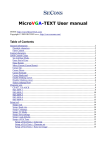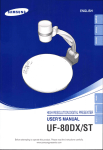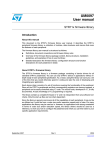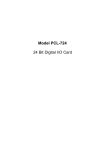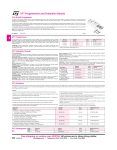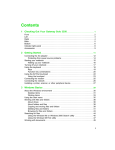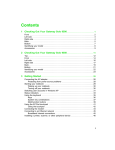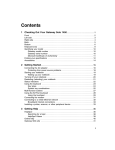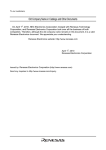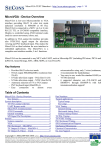Download uVGA-CONIO-LIB - Micro VGA: Cost-effective Microcontroller VGA
Transcript
MicroVGA conio/text user interface
library and demo Manual
WWW: http://www.MicroVGA.com/
Copyright © 2009 SECONS s.r.o., http://www.secons.com/
Table of contents
MicroVGA conio/text user interface library and demo Manual...........................................................1
Library license (GNU GPL).................................................................................................................2
Standard conio routines........................................................................................................................3
Output functions..............................................................................................................................3
Input functions.................................................................................................................................7
Low-level hardware routines...........................................................................................................7
Symbolic color constants.................................................................................................................9
User interface functions......................................................................................................................11
Demo Application...............................................................................................................................14
Directory contents..........................................................................................................................14
General description........................................................................................................................15
STR712 MCU project....................................................................................................................16
PIC24 MCU project description....................................................................................................17
NEC78k0s MCU ...........................................................................................................................17
LPC21xx MCU project .................................................................................................................18
TMS470 MCU project ..................................................................................................................18
AVR (Atmel ATmega) MCUs project description.........................................................................19
Library license (GNU GPL)
This program is free software: you can redistribute it and/or modify it under the terms of the GNU
General Public License as published by the Free Software Foundation, either version 3 of the
License, or (at your option) any later version.
This program is distributed in the hope that it will be useful, but WITHOUT ANY WARRANTY;
without even the implied warranty of MERCHANTABILITY or FITNESS FOR A PARTICULAR
PURPOSE. See the GNU General Public License for more details.
You should have received a copy of the GNU General Public License along with this program. If
not, see <http://www.gnu.org/licenses/>.
Standard conio routines
These routines are hardware, architecture and compiler independent.
Output functions
_cputs
Puts a string to the MicroVGA.
void _cputs(const char *str);
Parameters
str
Output string
Description
The _cputs function writes the null-terminated string pointed to by str to the MicroVGA. A carriage
return–line feed (CR-LF) combination is not automatically appended to the string.
Requirements
Required header: <conio.h>
textattr
Sets both the foreground and the background colors in a single call.
void textattr(int attr);
Parameters
attr
Encodes color information:
7 6 5 4 3 2 1 0
Bb b b f f f f
In this 8-bit newattr parameter:
•
ffff = 4-bit foreground color (0 to 15).
•
bbb = 3-bit background color (0 to 7).
•
B = blink-enable bit.
Description
This function does not affect any characters currently shown on the screen. Once you have called
this function, all subsequent functions using direct video output (such as _cputs) will use the new
attributes or colors.
If you use Symbolic color constant, the following limitations apply to the background colors you
select:
•
You can only select one of the first eight colors (0--7).
•
With textattr, you must shift the selected background color to the left by 4 bits to move it
into the correct "bbb" bit positions.
Requirements
Required header: <conio.h>
textbackground
Selects a new text background color.
void textbackground(int color);
Parameters
color
Encodes background color:
7 6 5 4 3 2 1 0
x x x x B b b b
In this 8-bit newattr parameter:
•
xxxx = 4-bit unused.
•
bbb = 3-bit background color (0 to 7).
•
B = blink-enable bit.
Description
This function does not affect any characters currently shown on the screen. Once you have called
this function, all subsequent functions using direct video output (such as _cputs) will use the new
attributes or colors.
If you use symbolic color constants the following limitations apply to the background colors you
select:
•
You can only select one of the first eight colors (0--7).
Requirements
Required header: <conio.h>
textcolor
Selects the foreground character color.
void textcolor(int color);
Parameters
color
Encodes foreground color:
7 6 5 4 3 2 1 0
x x x x f f f f
In this 8-bit newattr parameter:
•
xxxx = 4-bit unused.
•
ffff = 4-bit foreground color (0 to 15).
Description
This function does not affect any characters currently shown on the screen. Once you have called
this function, all subsequent functions using direct video output (such as _cputs) will use the new
attributes or colors.
You can use symbolic color constants to specify foreground color.
Requirements
Required header: <conio.h>
clrscr
Clears the screen.
void clrscr(void);
Description
Clears the current screen and places the cursor in the upper left-hand corner (at position 1,1).
Requirements
Required header: <conio.h>
crleol
Clears characters to the end of line on the screen.
void clreol(void);
Description
Clears all characters from the cursor position to the end of the line, without moving the cursor.
Current background color is applied.
Requirements
Required header: <conio.h>
gotoxy
Positions cursor on the screen.
void gotoxy(char x, char y);
Parameters
x
Horizontal position relative to the origin of the screen (upper-left corner [1,1]).
Maximum value is 80.
y
Vertical position relative to the origin of the screen (upper-left corner [1,1]).
Maximum value is 25.
Description
Moves the cursor to the given position on the screen. If the coordinates are invalid (out of screen),
the call to gotoxy is ignored.
Requirements
Required header: <conio.h>
cursoron
Displays the cursor.
void cursoron(void);
Description
Switches the cursor on at current position.
Requirements
Required header: <conio.h>
cursoroff
Hides the cursor.
void cursoroff(void);
Description
Switches the cursor off (i.e. the cursor is no longer visible).
Requirements
Required header: <conio.h>
Input functions
_cgets
Gets a character string from the MicroVGA.
char * _cgets(char *s);
Parameters
s
Storage location for data.
Return value
The _cgets function return a pointer to the start of the string, at buffer[2].
Description
The _cputs function reads a string of characters from the MicroVGA and stores the string and its
length in the location pointed to by s. The s parameter must be a pointer to a character array. The
first element of the array, s[0], must contain the maximum length (in characters) of the string to be
read. The array must contain enough elements to hold the string, a terminating null character ('\0'),
and 2 additional bytes. The function reads characters until a carriage return–line feed (CR-LF)
combination or the specified number of characters is read. The string is stored starting at s[2]. The
function then stores the actual length of the string in the second array element, s[1]. If escape key is
pressed, getting string is canceled and zero length string is returned (s[1] is equal to 0).
Requirements
Required header: <conio.h>
Low-level hardware routines
These hardware dependent functions must be implemented by the user.
_getch
Gets a character from the MicroVGA without echo.
int _getch (void);
Return value
Returns the character read. There is no error return.
Description
The _getch function reads a single character or extended character (function key, arrow key) from
the MicroVGA without echoing the character. Extended character is two byte long. Single character
is one byte long.
Implementation
UART is used to read keyboard input from MicroVGA. Reading single ASCII character is very
simple, extended character such as F-keys or cursor movement is read in two steps. First byte read
from MicroVGA, is zero, then next byte contains key code. If function key code is read, it's value is
added or-ed with 0x100 in order to distinguish from printable ASCII codes. For example key F4 is
read as two bytes 0x00 and then 0x3E, but function returns code 0x013E.
Example of implementation
int _getch (void)
{
int ch;
//wait until data is received
while(!isNewDataAvailable());
//read first byte from UART
UART_ByteReceive(&ch);
if (ch == 0)
{ //extended key pressed, read second byte
//wait until data is received
while(!isNewDataAvailable());
UART_ByteReceive(&ch);
//Set first byte to one
ch = 0x100 | ch;
}
return ch;
}
Requirements
Required header: <conio.h>
_cputch
Writes a character to the MicroVGA.
void _putch (char ch);
Parameters
ch
Character to be output.
Description
The _cputch function writes single character ch to the MicroVGA.
Implementation
MCU UART module is usually used to write data to MicroVGA.
Example of implementation
void _putch (char ch)
{
//Wait uVGA to be ready to receive data
//low -> uVGA is ready to recv data
while (BitRead(CTS_PIN_NUMBER));
//Write byte to UART
UART_ByteSend(&ch);
//wait until the data transmission is finished
while(!uart_write_finished()) ;
}
Requirements
Required header: <conio.h>
_kbhit
Checks the MicroVGA for keyboard input.
int _kbhit (void);
Return value
The _kbhit function returns a nonzero value if a key has been pressed. Otherwise, it returns 0.
Description
The _kbhit function checks the MicroVGA for a recent keystroke. If the function returns a nonzero
value, a keystroke is waiting in the buffer. The program can then call _getch to get the keystroke.
Implementation
UART is used to read/write data from/to MicroVGA. A given UART state register should be read to
detect keypress.
Requirements
Required header: <conio.h>
Symbolic color constants
Constant
Value Background Foreground
BLACK
0
Yes
Yes
RED
1
Yes
Yes
GREEN
2
Yes
Yes
BROWN
3
Yes
Yes
BLUE
4
Yes
Yes
MAGENTA
5
Yes
Yes
CYAN
6
Yes
Yes
LIGHTGRAY
7
Yes
Yes
DARKGRAY
8
No
Yes
LIGHTRED
9
No
Yes
LIGHTGREEN
10
No
Yes
YELLOW
11
No
Yes
LIGHTBLUE
12
No
Yes
LIGHTMAGENTA 13
No
Yes
LIGHTCYAN
14
No
Yes
WHITE
15
No
Yes
BLINK
128
No
---
User interface functions
drawfkeys
Display Northon Commander-style function key bar on bottom of the screen.
void drawfkeys(const char *fkeys[]);
Parameters
fkeys
Array of strings to display in the menu.
Description
The drawfkeys iterate through fkeys array of string and display every string on the bottom of the
screen. Displayed menu looks like Northon Commander function key menu. Input array of strings
(fkeys) must contain ten (10) elements. String printing is skipped, if zero is specified in the place of
string in fkeys array. Next string is printed in a next position.
Example
const static char *memview_fkeys[10] =
{"Help",0,0,0,"DynMem",0,0,0,0,"Quit"};
drawfkeys(memview_fkeys);
Requirements
Required header: <ui.h>
runmenu
Displays text-based selection menu on the screen.
int runmenu(char x, char y, const char *menu[], int defaultitem);
Parameters
x
Horizontal position of upper-left corner of menu frame. Position is relative to the
origin of the screen (upper-left corner [1,1]). Maximum value is 80.
y
Vertical position of upper-left corner of menu frame. Position is relative to the
origin of the screen (upper-left corner [1,1]). Maximum value is 25.
menu
Array of strings to display in the menu. Last item must be zero (0), to indicate the
end of array.
defaultitem
Item of the menu, that will be highlighted as selected.
Return value
The runmenu function return index of item, that was selected, when enter key was pressed.
Description
The runmenu function displays text-based menu, that allows the user, to select desired item.
Selection is made by pressing down/up arrow key. The runmenu function terminates and returns
the selected item index, when enter key is pressed. This index is then used by application to run
desired code, that is dependent on menu selection.
The height of the menu frame is defined by number of items in the menu array of strings. The width
is defined by longest string in the menu array.
Example
const static char *mainmenu[] =
{
"Memory viewer",
"Console debug demo",
"Speed test",
"Test sub menu",
"Command line interface",
"ASCII-Art test",
"Input dialog test",
0
};
//...
while (1) {
item = runmenu(5,5, mainmenu, item);
switch (item) {
case 1:
memviewer(0); break;
case 2:
debugdemo(); break;
case 3:
speedtest(); break;
case 4:
submenutest(); break;
case 5:
cli(); break;
case 6:
ascii_art(); break;
case 7:
testCGetS(); break;
}
Requirements
Required header: <ui.h>
drawframe
Display empty frame on the screen.
void drawframe(int x, int y, int width, int height, int color);
Parameters
x
Horizontal position of upper-left corner of the frame. Position is relative to the
origin of the screen (upper-left corner [1,1]). Maximum value is 80.
y
Vertical position of upper-left corner of the frame. Position is relative to the origin
of the screen (upper-left corner [1,1]). Maximum value is 25.
width
Length of text, that can be printed into the frame.
height
Number of lines, that can be printed into the frame.
color
Border (text) and background color of the frame. Refer to textattr function for color
specification.
Description
The drawframe function displays empty frame in the specified position on the screen. Border of
the frame is created from box drawing characters hence the color parameter alter background and
border/text color same as the textattr function. Width parameter specifies length of text, that can be
printed into the frame, thus absolute width of the frame is four (4) characters bigger. (One [1]
border character and one [1] space on the left/right sides). The height parameter specifies number of
lines, that can be printed into the frame, thus the absolute height of the frame is four (4) characters
bigger. (One [1] border character and one [1] space on the top/bottom sides).
Requirements
Required header: <ui.h>
Demo Application
MicroVGA-conio demo application contains everything needed to begin creating user friendly
embedded applications, using low-cost 8bit microcontrollers or feature-rich 32-bit SoC. This demo
application fits even into 4kByte 8bit microcontroller!
Directory contents
Root directory of demo application consists of the following files and directories:
Name
Type
Description
h
dir
Contains header files of conio MicroVGA library(Common for every
MCU).
Lib
dir
Contains C files of conio MicroVGA library(Common for every MCU).
pic24_mplab dir
Contains MPLab project for PIC24 MCU. This project implements
specific hardware routines (_kbhit, _cgets, _cputs) for PIC24. These
routines are defined using UART including handshaking.
str712_iar
Contains IAR project for STR712 MCU. This project implements
hardware specific routines (_kbhit, _cgets, _cputs) for STR712. These
routines are defined using UART0 including handshaking.
dir
nec78k0s_iar dir
Contains IAR project for NEC 78k0 8bit MCUs
lpc21xx_iar
dir
Contains IAR project for NXP LPC2103/04/05/06
tms470_iar
dir
Contains IAR project for Texas Instruments TMS470R1Axxx
atmega128_a dir
vrstudio
Contains AVR Studio project for ATmega MCUs. This project implements
hardware specific routines (_kbhit, _cgets, _cputs) for Atmega103 (single-
uart) or Atmega128 (dual-uart). These routines are using UART with flowcontrol.
main.c
file
Contains main function, that is displaying the demo application. (Common
for every MCU)
aa.c
file
ASCII art demo
General description
The main Demo function calls MCU_Init function, which must be defined for every MCU
project. MCU_Init function should be used to initialize specific MCU (setting MCU clock
frequency, UART initialization and settings, ...). Thus this function is defined in MCU project as
well as hardware specific routines (_kbhit, _cgetch, _cputch). The main Demo function starts
calling library function to display the demo after MCU_Init call.
STR712 MCU project
Root STR712 MCU project directory contains following files and directories:
Name
Type
Description
include
dir
Contains header files for ST library configuration and interrupt
configuration.
library
dir
Directory where STR71x Firmware Library should be downloaded to
linker
dir
Contains linker files
startup
dir
ASM for initialization of ST MCU
71x_it.c
file
Interrupt service routines. Included only for linking (all service routines
are empty).
hw_st710.c
file
Using STR71x Firmware Library to implement hardware specific function
(_kbhit, _cputch, _cgetch and Init_MCU).
Project was created using IAR Embedded Workbench IDE V5.4.
Project is using UART0 for communication. This can be easily changed by Use_UARTx
define in hw_st710.c. Pins P1_4 and P1_5 are used for UART handshaking. Pins numbers are set by
RTS_PIN_NUMBER and CTS_PIN_NUMBER define. UART communication speed (baudrate),
can be set using ST library function UART_Config. Note that UART baudrate depends on PCLK1
frequency. Real baudrate is subject of division and rounding and can be different from value, that is
passed to UART_Config. (Refer to STR71xF reference manual).
STR71x Firmware Library is not included in Demo Application (license reasons), but can be
downloaded at http://www.st.com/stonline/products/support/micro/files/str71xfwlib.zip for free.
Pin
Direction Connect to uVGA Description
P1.4
OUT
RTS
Pin is set (written) high to stop MicroVGA sending data.
Pin is set (written) low to allow MicroVGA sending data.
P1.5
IN
CTS
Pin is read to find out, if MicroVGA is able to receive
data. High means that MicroVGA is busy, low means
ready to receive.
P0.8
IN
TXD
Standard UART receive pin.
P0.9
OUT
RXD
Standard UART transmit pin.
PIC24 MCU project description
Root PIC24 MCU project directory consists of following files and directories:
Name
Type Description
hw_pic24.c
file
Implementing specific hardware functions (_kbhit, _cputch, _cgetch
and Init_MCU)
p24HJ32GP202.h file
PIC24 MCU header file (register memory and peripheral devices
definitions).
Oscillator: internal
NEC78k0s MCU
Root NEC78k0s MCU project directory contains the following files and directories:
Name
Type Description
hw_78k0s.c
file
Implementing specific hardware functions (_kbhit, _cputch, _cgetch
and Init_MCU)
DF9222_V4.XCL file
Linker file for NEC78k0s.
Project was created using IAR Embedded Workbench Kickstart for NEC 78k V4.2, which is
shipped with NEC Low Pin Count Do It Starter Kit
(http://www.eu.necel.com/products/micro/065_dev_tools/030_starterkits/010_starterkits_78K0S/ind
ex.html). Low-pin-count Do it! Demonstration board was used as a host hardware. (schematic
diagram is available at http://www.eu.necel.com/_pdf/U18139EE1V0UM00.PDF).
Please note that NEC78k0s has only 4kB of memory, which limits the demonstration
application. (Some features were removed for use with this MCU).
Pin
Dir
Connect to uVGA
Description
P20 (CN12.5)
IN
CTS
Pin is read to find out, if MicroVGA is able to
receive data. High means that MicroVGA is
busy, low means ready to receive.
P44_RxD6 (CN12.7) IN
TXD
Standard UART receive pin.
P43_TxD6 (CN12.9) OUT RXD
Standard UART transmit pin.
Connect MicroVGA to the LPC-DOIT board using red-marked pins:
LPC21xx MCU project
Root LPC21xx MCU project directory consists of following files and directories:
Name
Type Description
hw_lpc21xx.c
file
Implementing specific hardware functions (_kbhit, _cputch, _cgetch
and Init_MCU)
ma_sfr.h
file
Special function register bitfield macros.
Project was created using IAR Embedded Workbench IDE V5.4. Phillips LPC2104 MCU
was
used.
More
information
about
this
MCU
can
be
found
at
http://www.nxp.com/#/pip/pip=[pip=LPC2104_2105_2106_7]|
pp=[t=pip,i=LPC2104_2105_2106_7].
Pin
Dir
Connect to uVGA Description
P0.3
OUT RTS
Pin is set (written) high to stop MicroVGA sending data.
Pin is set (written) low to allow MicroVGA sending data.
P0.2
IN
CTS
Pin is read to find out, if MicroVGA is able to receive
data. High means that MicroVGA is busy, low means
ready to receive.
P0.1/RXD0 IN
TXD
Standard UART receive pin.
P0.0/TXD0 OUT RXD
Standard UART transmit pin.
TMS470 MCU project
Root TMS470 MCU project directory consists of following files and directories:
Name
Type Description
hw_tms470.c
file
Implementing specific hardware functions (_kbhit, _cputch, _cgetch
and Init_MCU)
cstartup.s
file
Contains low-level initialization of TMS470 MCU
Configuration_Files dir
Contains configurations files (linker file, init files) for specific
TMS470 MCU version.
Project was created using IAR Embedded Workbench IDE V5.4. Texas Instruments
TMS470R1A128 MCU was used. More information about this MCU can be found at
http://focus.ti.com/docs/prod/folders/print/tms470r1a128.html.
Pin
Dir
Connect to uVGA Description
C2SIaRX
OUT RTS
Pin is set (written) high to stop MicroVGA sending data.
Pin is set (written) low to allow MicroVGA sending data.
C2SIaTX
IN
CTS
Pin is read to find out, if MicroVGA is able to receive
data. High means that MicroVGA is busy, low means
ready to receive.
SCI1RX
IN
TXD
Standard UART receive pin.
SCI1TX
OUT RXD
Standard UART transmit pin.
AVR (Atmel ATmega) MCUs project description
Root of AVR MCU project directory consist of following files and directories:
Name
Type Description
hw_atmega128.c
file
Oscillator: internal 1 MHz
Implementing hardware specific function (_kbhit, _cputch, _cgetch
and Init_MCU)



















